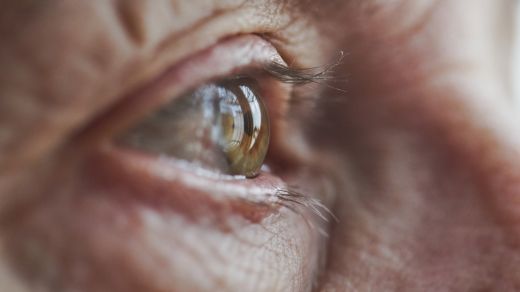In an eye attack, the arteries in the eye become blocked. The result: sudden loss of vision. In such a case, it is important to react quickly. Because only with immediate treatment do those affected have the chance to avoid permanent damage to the eye.
- © Getty Images/Rhys Hayward (icon image)
quick overview
What is an eye attack? It is a circulatory disorder of the eye, which leads to a sudden deterioration in vision.
Symptoms: Blurred vision, reduced field of vision, deterioration in visual acuity, complete loss of vision
Causes: Obstruction of vessels by deposits or a blood clot
Treatment: Massage of the eyeball, blood circulation-enhancing drugs, drugs to dissolve blood clots (lysis therapy)
Article content at a glance:
What is an eye attack?
An eye infarction, medically known as anterior ischemic optic neuropathy (AION), is an artery blockage in the eye that causes vision to deteriorate within seconds. The blockage causes circulatory disorders that permanently damage the retina and, in extreme cases, can even lead to blindness.
Eye infarction is a rare disease. One in 10,000 people suffers an infarction in the eye. He mostly appears from the age of 60 years. Men are affected slightly more often than women. In such a case, it is important to react quickly, because the eye attack is an ophthalmological emergency that must be treated immediately. The earlier treatment begins, the better the chances of preserving or restoring vision.
Symptoms: How to recognize an eye attack?
In the case of an eye attack, the symptoms appear suddenly and usually only affect one eye at a time. A sudden, painless loss of vision or a severe impairment of vision is typical. Some people describe this as a “curtain” falling across their field of vision.
Other possible eye infarction symptoms are
- distorted vision,
- decreased color perception or
- a blurred field of vision.
Causes of an eye attack
The most common cause of an eye attack is blockage of the central artery in the eye, which supplies the retina with oxygen and nutrients. The occlusion is triggered, similar to a heart attack or stroke, by deposits in the vessels or by blood clots that block the blood vessel like a plug.
The clot can form locally in the blood vessels of the eye or elsewhere and then travel to the eye. A narrowing or blockage of the arteries in the eye can also restrict blood flow and trigger an eye attack.
forms of ocular infarction
Depending on the cause, a distinction is made between the following two forms:
arteritic anterior ischemic optic neuropathy (AAION): In this form, there is inflammation of the vessel walls in the area of the optic nerve. A common cause is what is known as giant cell arteritis – a chronic inflammation of the large and medium-sized arteries in the head, neck and upper body. The inflammation causes the arterial blood vessels in the eye to constrict, disrupting the blood supply. With an AAION, both eyes can be affected and symptoms such as headaches or pain when chewing can occur.
Nonarteritic Anterior Ischemic Optic Neuropathy (NAAION): In this form there is no inflammation. It is caused by deposits in the vessels or by a blood clot.
In addition, other causes can also trigger an ocular infarction, such as a vein occlusion in the eye, also known as ocular thrombosis. This is when a blood clot blocks a vein that drains blood from the eye. The blockage causes blood to congest and swelling, which squeezes adjacent arteries and leads to an acute lack of oxygen in the tissue.
Risk factors for an ocular infarction
Above all, the non-inflammatory form of ocular infarction is favored by certain risk factors. These are often the same risk factors as in other cardiovascular diseases.
This includes:
Increased intraocular pressure or a sudden drop in blood pressure, for example after an operation, can also promote an ocular infarction.
The information is being spread on social media that a corona vaccination increases the risk of an eye attack. However, there is no corresponding scientific evidence for this connection.
How dangerous is an eye attack?
In an eye attack, the blood supply to the eye is blocked. The retina can therefore no longer be supplied with oxygen. Within a very short time, this leads to the tissue dying and serious damage such as blindness can occur. To avoid this, the eye infarction should be treated immediately by a doctor.
Diagnosis of an ocular infarction
In order to diagnose an eye infarction, the ophthalmologist carries out various examinations such as:
- a visual acuity test,
- a visual field measurement,
- the examination of the pupil reaction as well as
- an examination of the fundus of the eye.
Since eye attacks often indicate general cardiovascular or vascular diseases, examinations such as an ECG, ultrasound of the blood vessels and the heart and other examinations for cardiovascular diseases and blood clotting disorders may be necessary. This is intended to rule out the risk of further vascular occlusions, which can lead to strokes, heart attacks or venous thrombosis.
treatment of an ocular infarction
Various treatment options are available depending on the cause of the infarction and when it occurred. If treatment can be started immediately after the infarction, the main aim is to improve blood circulation in the eye in order to avoid damage such as blindness. The treatment options then include massaging the eyeball (bulb massage) and the administration of blood circulation-enhancing drugs, which are often administered by direct injection into the eye.
Another therapy approach is the so-called lysis therapy, which is also used to treat strokes in the brain. A drug is given to dissolve the blood clot.
If there are risk factors or underlying diseases such as high blood pressure, diabetes mellitus or vascular diseases, these are treated to prevent another eye attack.
When vision becomes permanently impaired, visual rehabilitation can help maximize remaining vision. This may include using corrective lenses, attending training to manage vision loss, and making lifestyle changes to make everyday life easier.
Minimize risk – prevent eye attacks
People with diabetes mellitus, vascular diseases, high blood pressure or elevated blood lipid levels have an increased risk of suffering an eye attack. You should therefore have regular check-ups, have your blood values checked and take the prescribed medication conscientiously. In addition, further measures are recommended to prevent an eye attack:
- smoking cessation: Smoking is considered to be a particularly high risk for vascular diseases such as an eye attack. A consistent smoking cessation can reduce this risk.
healthy and balanced diet: This includes above all the daily consumption of fruit, vegetables, whole grain products and legumes. Products rich in fat and sugar should be reduced. Fish and meat can be on the menu once or twice a week.
drink a lot: At least one and a half liters of liquid in the form of water or unsweetened tea is recommended daily.
Movement: Endurance sports such as cycling, walking or swimming reduce the risk of cardiovascular disease. Regular walks also have a preventive effect.
Reduce stress: Stress is one of the biggest risk factors for cardiovascular disease. Stress reduction through regular breaks in everyday life and with the help of relaxation methods such as yoga can counteract this.



